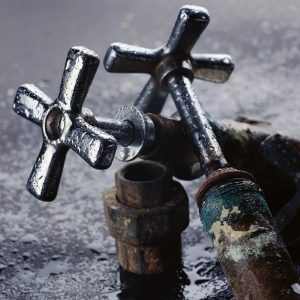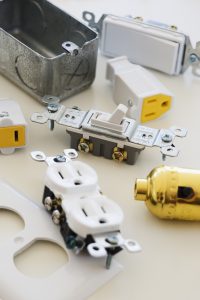 As per the International Standards of Practice for Performing a General Home Inspection set by the International Association of Certified Home Inspectors, B to B Home Inspections will inspect the plumbing and electrical in the home abiding by the following:
As per the International Standards of Practice for Performing a General Home Inspection set by the International Association of Certified Home Inspectors, B to B Home Inspections will inspect the plumbing and electrical in the home abiding by the following:
Plumbing
Ed Lawton, the inspector at B to B Home Inspections, shall inspect the plumbing of the home. At the time of this part of the inspection, the inspector will inspect:
- the main water supply shut-off valve;
- the main fuel supply shut-off valve;
- the water heating equipment, including the energy source, venting connections, temperature/pressure-relief (TPR) valves, Watts 210 valves, and seismic bracing;
- interior water supply, including all fixtures and faucets, by running the water;
- all toilets for proper operation by flushing;
- all sinks, tubs and showers for functional drainage;
- the drain, waste and vent system; and
- drainage sump pumps with accessible floats.
Description
The inspector shall describe:
- whether the water supply is public or private based upon observed evidence;
- the location of the main water supply shut-off valve;
- the location of the main fuel supply shut-off valve;
- the location of any observed fuel-storage system; and
- the capacity of the water heating equipment, if labeled.
Report
The inspector shall report as in need of correction:
- deficiencies in the water supply by viewing the functional flow in two fixtures operated simultaneously;
- deficiencies in the installation of hot and cold water faucets;
- mechanical drain stops that were missing or did not operate if installed in sinks, lavatories and tubs; and
- toilets that were damaged, had loose connections to the floor, were leaking, or had tank components that did not operate.
Please note, the inspector is not required to:
- light or ignite pilot flames.
- measure the capacity, temperature, age, life expectancy or adequacy of the water heater.
- inspect the interior of flues or chimneys, combustion air systems, water softener or filtering systems, well pumps or tanks, safety or shut-off valves, floor drains, lawn sprinkler systems, or fire sprinkler systems.
- determine the exact flow rate, volume, pressure, temperature or adequacy of the water supply.
- determine the water quality, potability or reliability of the water supply or source.
- open sealed plumbing access panels.
- inspect clothes washing machines or their connections.
- operate any valve.
- test shower pans, tub and shower surrounds or enclosures for leakage or functional overflow protection.
- evaluate the compliance with conservation, energy or building standards, or the proper design or sizing of any water, waste or venting components, fixtures or piping.
- determine the effectiveness of anti-siphon, back-flow prevention or drain-stop devices.
- determine whether there are sufficient cleanouts for effective cleaning of drains.
- evaluate fuel storage tanks or supply systems.
- inspect wastewater treatment systems.
- inspect water treatment systems or water filters.
- inspect water storage tanks, pressure pumps, or bladder tanks.
- evaluate wait time to obtain hot water at fixtures, or perform testing of any kind to water heater elements.
- evaluate or determine the adequacy of combustion air.
- test, operate, open or close: safety controls, manual stop valves, temperature/pressure-relief valves, control valves, or check valves.
- examine ancillary or auxiliary systems or components, such as, but not limited to, those related to solar water heating and hot water circulation.
-
determine the existence or condition of polybutylene plumbing.
-
inspect or test for gas or fuel leaks, or indications thereof.
As Per NJ State Standards
When inspecting the plumbing system, a home inspector shall:
1) Inspect:
i) Interior water supply and distribution systems including functional water flow and functional drainage, excluding wells, well pumps, well water sampling or water storage related equipment, determination of water supply quantity or quality and water conditioning systems and lawn irrigation systems;
ii) All interior fixtures and faucets, excluding shut off valves, wells, well pumps, well water sampling and water storage related equipment;
iii) Drain, waste and vent systems;
iv) Domestic water heating systems, without operating safety valves or automatic safety controls, and excluding solar water heating systems;
v) Combustion vent systems excluding interiors of flues and chimneys;
vi) Fuel distribution systems; and
vii) Drainage sumps, sump pumps and related piping; and
2) Describe:
i) Predominant interior water supply and distribution piping materials;
ii) Predominant drain, waste and vent piping materials; and
iii) Water heating equipment including energy sources.
References
“International Standards of Practice for Performing a General Home Inspection.” InterNACHI. N.p., June 2013. Web. 07 June 2016.
“13:40-15.16 STANDARDS OF PRACTICE.” NEW JERSEY ADMINISTRATIVE CODE: HOME INSPECTION ADVISORY COMMITTEE: Home Inspection Advisory Committee (n.d.): n. pag. NJ Consumer Affairs. 20 Apr. 2015. Web.
 Electrical
Electrical
Ed Lawton, the inspector at B to B Home Inspections, shall inspect the electrical components of the home. At the time of this part of the inspection, the inspector will inspect:
- the service drop;
- the overhead service conductors and attachment point;
- the service head, gooseneck and drip loops;
- the service mast, service conduit and raceway;
- the electric meter and base;
- service-entrance conductors;
- the main service disconnect;
- panelboards and over-current protection devices (circuit breakers and fuses);
- service grounding and bonding;
- a representative number of switches, lighting fixtures and receptacles, including receptacles observed and deemed to be arc-fault circuit interrupter (AFCI)-protected using the AFCI test button, where possible;
- all ground-fault circuit interrupter receptacles and circuit breakers observed and deemed to be GFCIs using a GFCI tester, where possible; and
- smoke and carbon-monoxide detectors.
Description
The inspector shall describe the main service disconnect’s amperage rating, if labeled; and the type of wiring observed.
Report
The inspector shall report as in need of correction:
- deficiencies in the integrity of the service-entrance conductors’ insulation, drip loop, and vertical clearances from grade and roofs;
- any unused circuit-breaker panel opening that was not filled;
- the presence of solid conductor aluminum branch-circuit wiring, if readily visible;
- any tested receptacle in which power was not present, polarity was incorrect, the cover was not in place, the GFCI devices were not properly installed or did not operate properly, evidence of arcing or excessive heat, and where the receptacle was not grounded or was not secured to the wall; and
- the absence of smoke detectors.
Please note, the inspector is not required to:
- insert any tool, probe or device into the main panelboard, sub-panels, distribution panelboards, or electrical fixtures.
- operate electrical systems that are shut down.
- remove panelboard cabinet covers or dead fronts.
- operate or re-set over-current protection devices or overload devices.
- operate or test smoke or carbon-monoxide detectors or alarms.
- inspect, operate or test any security, fire or alarm systems or components, or other warning or signaling systems.
- measure or determine the amperage or voltage of the main service equipment, if not visibly labeled.
- inspect ancillary wiring or remote-control devices.
- activate any electrical systems or branch circuits that are not energized.
- inspect low-voltage systems, electrical de-icing tapes, swimming pool wiring, or any time-controlled devices.
- verify the service ground.
- inspect private or emergency electrical supply sources, including, but not limited to: generators, windmills, photovoltaic solar collectors, or battery or electrical storage facility.
- inspect spark or lightning arrestors.
- inspect or test de-icing equipment.
- conduct voltage-drop calculations.
- determine the accuracy of labeling.
- inspect exterior lighting.
As Per NJ State Standards
When inspecting the electrical system, a home inspector shall:
1) Inspect:
i) Service entrance system;
ii) Main disconnects, main panel and sub panels, including interior components of main panel and sub panels;
iii) Service grounding;
iv) Wiring, without measuring amperage, voltage or impedance, excluding any wiring not a part of the primary electrical power distribution system, such as central vacuum systems, remote control devices, telephone or cable system wiring, intercom systems, security systems and low voltage wiring systems;
v) Over-current protection devices and the compatibility of their ampacity with that of the connected wiring;
vi) At least one of each interior installed lighting fixture, switch, and receptacle per room and at least one exterior installed lighting fixture, switch, and receptacle per side of house; and
vii) Ground fault circuit interrupters; and
2) Describe:
i) Amperage and voltage rating of the service;
ii) Location of main disconnect, main panels, and sub-panels;
iii) Type of over-current protection devices;
iv) Predominant type of wiring;
v) Presence of knob and tube branch circuit wiring; and
vi) Presence of solid conductor aluminum branch circuit wiring.
References
“International Standards of Practice for Performing a General Home Inspection.” InterNACHI. N.p., June 2013. Web. 07 June 2016.
“13:40-15.16 STANDARDS OF PRACTICE.” NEW JERSEY ADMINISTRATIVE CODE: HOME INSPECTION ADVISORY COMMITTEE: Home Inspection Advisory Committee (n.d.): n. pag. NJ Consumer Affairs. 20 Apr. 2015. Web.
